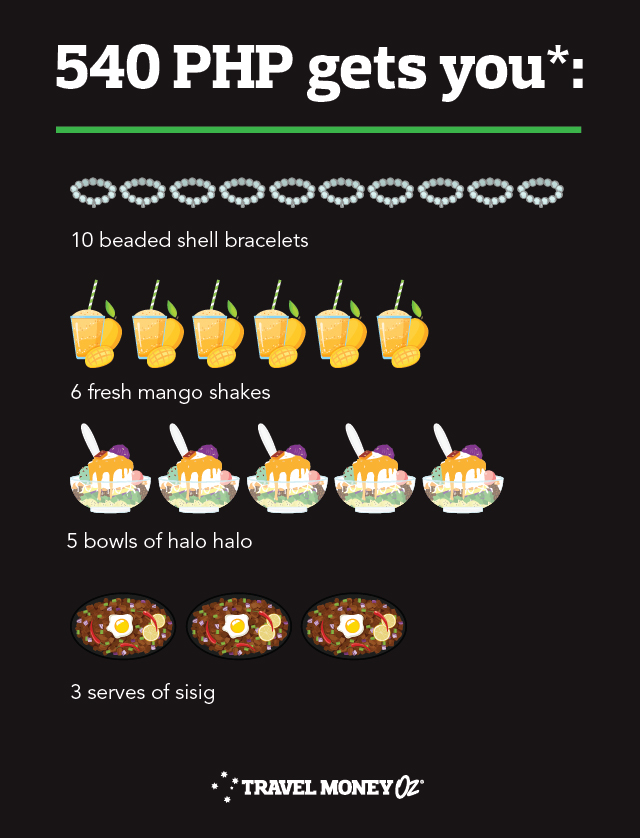Guide to PHP Forecasts
Are you spending your days dreaming of a balmy beach in the Philippines, ice cold fruity cocktail in one hand and Chicken adobo in the other? I know I am. It certainly adds to the fantasy when all that would cost about the equivalent of $5AUD thanks to the lower cost of living in the Philippines and the relative strength of the Australian Dollar against the Philippine Peso (or Piso) too.
Yes, you heard that right – Peso. Due to its former place in the Spanish Empire, the official currency of the Philippines is the Peso. Along with countries like Argentina, Chile, Colombia, Cuba, Dominican Republic, Mexico, the Philippines, and Uruguay who also have kept a version of the Peso as their official currency.
Before we get down to brass tax, a few fun facts about the Philippine Peso.
3 things you didn’t know about the Philippine Peso
1. It is not uncommon for shopkeepers to not have enough coins for change. Not because there’s not enough coins on the islands, but because most of the coins are locked away in people’s piggy-banks and jars for savings. The Philippine Central Bank constantly urges its citizens to bank the coins instead to get them back into circulation!
2. In 2007, around 1000 of the brand new 100 Peso notes were printed with the incorrect spelling of former President Gloria Macapagal-Arroyo’s name and sent into circulation. Keep your eyes peeled for a 100 Peso note spelling “Arrovo” instead because the notes are highly prized by collectors.
3. During the WW2 occupation by Japan, the Philippine Government in exile printed "guerrilla pesos" which were designed to be redeemed in silver pesos after the war had finished. These guerrilla pesos were highly illegal and you could be executed or shot for possessing them!
Now, let’s get stuck into the nitty of the Philippine Peso outlook and forecast for the rest of the year so you can start planning your trip and having a play with your handy budget calculator. We know how much it pays to stay on top of fluctuating exchange rates, so we’ve put together an outline of what the boffins at the bank have forecast for the AUD/PHP exchange rates for Q3 and Q4 of 2020.
AUD to PHP Forecasts
| AUD/PHP | Mean (of 30 bank forecasts) | Westpac | Citigroup | |||
| Seasonality | Q3 | Q4 | Q3 | Q4 | Q3 | Q4 |
| Exchange Rate | 34.71 | 34.93 | 33.9 | 33.63 | 33.9 | 33.9 |
| Exchange 2k in AUD | 69,420PHP | 69,860PHP | 67,800PHP | 67,260PHP | 67,800PHP | 67,800PHP |
| Difference | 440 PHP | 540 PHP | 0 | |||
Data correct as of March 2, 2020.
What does this mean though? Well, let's use Westpac as an example.
As you can see, the big banks don’t always agree on exactly which way currency exchange markets are going to go. These differences in forecasting are partially due to the extreme amount of data that goes into forecasting foreign exchange markets, and also just that the world is by nature a very hard thing to predict!
Banks and economists use dozens of different sets of data and other sources of information to put together their forecasts, but with a little bit of research Aussie travellers can get a pretty good insight into the dynamics affecting fluctuations in the value of the AUD against the PHP.
First of all, you might have to wrap your head around a little bit of the technical jargon economists use along with the macroeconomic fundamentals and their influence on exchange rates.
Appreciation
When the value of one currency increases relative to another. E.g. When the AUD goes from 47 PHP to 49 PHP it has appreciated. Travellers appreciate this too, because it means more spending money and who doesn’t appreciate that?
Depreciation
Is when the value of a currency decreases relative to another. E.g. When the AUD drops from 49 PHP back to 47 PHP it has depreciated and you are depressed.
Higher valued currency
Cheaper imports (no more abandoning that online shopping cart), more expensive exports and extra spending money at the markets.
Lower valued currency
Means more expensive imports, cheaper exports, more people overseas and less cash for your Philippine adventure.
Inflation
The rate at which the general level of prices for goods and services is rising and, in turn, a currency’s purchasing power is falling. In other words, $10 back in the day used to get you a lot more than it does now - over time the value of a currency decreases as a result of supply and demand.
Economic growth
The increase in an economy’s capacity to produce goods and services. Growth is generally good, but we don’t want it to be too fast.
Dovish vs Hawkish
These are terms that refer to the general sentiment of a country’s central or reserve bank when talking about monetary policy.
A hawkish outlook occurs when they want to prevent excessive inflation, usually by increasing interest rates. In the absence of other major economic issues, increasing interest rates generally puts upward pressure on the value of that country’s currency, as investors can now get a greater return.
Taking a dovish stance happens when the economy is not growing and the government is seeking to negate deflation. Central banks with a dovish outlook tend to decrease interest rates which would put downward pressure on the value of the currency.
Hang onto your cocktail, now it’s on to the trickier stuff. These are the things that really stir up foreign exchange markets and affect currency forecasts.





Don’t feel like you know all the ins and outs of the currency forecasting world yet? That’s ok, even the professionals are learning every day. The main thing to remember is that a lot of things go into forecasting foreign exchange rates and a multitude of factors can give a currency a boost upwards, or can pull it downwards and not everyone gets it right.
One of the biggest and most important to identify drivers of a currency’s value is consumer sentiment. Consumer sentiment is a reflection of the broader economic climate and how the market views a currency. The more confidence investors have in an economy the better the currency usually performs. Events such as knifing Prime Ministers, Trade Wars, dropping interest rates and natural disasters can all have a major effect on consumers’ confidence in both the country and the currency. Think of it like this:
More trust = more people willing to invest in the country = greater demand for currency = appreciation
Less trust = less foreign capital invested into country = decreased demand for currency = depreciation
Still don’t feel like you’ve got it all? Don’t worry. We’ll do all the hard work while you relax and we’ll let you know when the AUD hits your preferred PHP rate, just sign yourself up for our Rate Alerts.
When you do bite the bullet and exchange your precious Aussie dollars, don’t forget to add Rate Move Guarantee to your transaction in store to protect yourself and your back pocket from any quick drops in currency value. It’s free and will protect you against exchange rate movements within 14 days of purchase. If it improves we will refund you the difference! How good is that?
*Prices are approximations based on the difference between mean estimates for AUD to PHP in Q3 2019 and Q4 2019. Keep in mind prices may vary across states and individual vendors. Cost and quantity estimations should be used as a guide only. This blog is provided for information only and does not take into consideration your objectives, financial situation or needs. You should consider whether the information and suggestions contained in any blog entry are appropriate for you, having regard to your own objectives, financial situation and needs. While we take reasonable care in providing the blog, we give no warranties or representations that it is complete or accurate, or is appropriate for you. We are not liable for any loss caused, whether due to negligence or otherwise, arising from use of, or reliance on, the information and/or suggestions contained in this blog. Terms and conditions apply to Rate Guard. See travelmoney.co.nz/rate-guard for more details.














